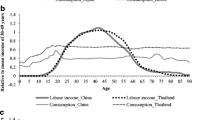Abstract
Post 2005 in India, a number of public policy initiatives were introduced to strengthen existing programs for welfare of the ever-increasing population aged 60 years and older. Using a National Transfer Accounts framework, this paper attempts to assess the implications of policy changes by evaluating changes in lifecycle deficit and changes in public and familial support of the elderly especially in meeting their lifecycle deficit between 2004 and 05 and 2011–12. It found that labour income of the elderly increased marginally during 2004–2012, but the level of consumption of the elderly marginally slipped down. Lifecycle deficit (LCD) of the elderly population aged 60 years and older declined due to the intertwining effect of increased labour income and declining consumption. Familial support to the elderly did not improve between 2004 and 2012, instead their net contribution to intra-household transfers is greater than their benefits. Asset based reallocation remains the main source of financing the LCD of the elderly. Benefits of the elderly in meeting their lifecycle deficit from policy changes is nominal.






Similar content being viewed by others
References
Arokiasamy, P., Bloom, D., Lee, J., Feeney, K., and Ozolins, M. (2011). Longitudinal aging study in India: vision, design, implementation, and some early results. PGDA Working paper No. 82, Harvard Initiative for Global Health. http”// www.hsph.harvard.edu/pgda/working accessed on January 31, 2016.
Bisht, S., & Sinha, D. (1981). Socialization, family and psychology differentiation. In D. Sinha (Ed.) Socialization of the Indian child (pp. 41–54). New Delhi: Concept.
Bongaarts, J., & Zimmer, Z. (2002). Living arrangements of older adults in the developing world: An analysis of demographic and health survey household surveys. The Journals of Gerontology Series b: Psychological Sciences and Social Sciences, 57(3), S145–S157.
Borooah, V. K. (2016). Gender disparities in health outcomes of elderly persons in India. Journal of South Asian Development, 11(3), 328–359.
Central Statistical Organization. (2008). National Accounts Statistics 2008. New Delhi: Ministry of Statistics and Programme Implementation, Government of India.
Central Statistical Organization. (2015). National Accounts Statistics 2015. New Delhi: Ministry of Statistics and Programme Implementation, Government of India.
Chaudhuri, A., & Roy, K. (2009). Gender differences in living arrangements among older persons in India. Journal of Asian and African Studies, 44(3), 259–277.
Croll, E. J. (2006). The intergenerational contract in the changing Asian family. Oxford Development Studies, 34(4), 473–491.
Desai, S and Vanneman R (2012). India Human Development Survey-II (2011-12). ICPSR 36151-v2. Ann Arbor, MI: Inter-university Consortium for Political and Social Research [distributor], 2015-07-31. http: //doi.org/10.3886/ICPSR36151.v2.
Desai, S., Dubey, A., Shariff, A., & Venneman, R. (2008). India Human Development Survey 2005. New Delhi: National Council of Applied Economic Research (New Delhi) and Ann Arbor: Inter-university Consortium for Political and Social Research. Available on: http://www.icpsr.umich.edu/ICPSR/access/index.html.
Government of India. (2007). The Maintenance and Welfare of Parents and Senior Citizens Act, 2007′,Ministry of Social Justice & Empowerment Justice & Empowerment. http://socialjustice.nic.in/oldageact.php. Accessed 25 April 2017.
Gupta, R., & Pillai, V. K. (2002). Elder care giving in South Asian families: Implications for social service. Journal of Comparative Family Studies, 33, 565–576.
Jadhav, A., Sathyanarayana, K. M., Kuma, S., & James, K. S. (2013). Living Arrangements of the Elderly in India: Who lives alone and what are the patterns of familial support. Busan, Korea: IUSSP.
Kaushal, N. (2014). How public pension affects elderly labor supply and well-being: Evidence from India. World Development, 56, 214–225.
Knodel, J., & Debavalya, N. (1997). Living arrangements and support among the elderly in South-East Asia: An introduction. Asia Pacific Population Journal, 12, 5–16.
Knodel, J., Friedman, J., Si Anh, T., & Cuong, B. T. (2000). Intergenerational exchanges in Vietnam: Family size, sex composition, and the location of children. Population Studies, 54(1), 89–104.
Ladusingh, L. (2013). Lifecycle deficit, intergenerational public and familial support system in India. Asian Population Studies, 9(1), 78–100.
Ladusingh, L., & Maharana, B. (2018). How sustainable is the familial support of elderly in Asia? Journal of Population Ageing, 11(4), 349–366.
Ladusingh, L., & Thangjam, M. (2018). Gender differential in occupation and income among the elderly in India. Ageing International, 43(2), 174–189.
Ladusingh, L., & Narayana, M. R. (2011). The role of familial transfers in supporting the lifecycle deficit in India. In R. Lee & A. Mason (Eds.), Population aging and the generational economy: A global perspective (pp. 459–474). Edward Elgar.
Rajan, S. I., & Kumar, S. (2003). Living arrangements among Indian elderly: New evidence from national family health survey. Economic and Political Weekly, 38(1), 75–80.
Rajasekhar, D., Kesavan, S., & Manjula, R. (2017). Are our contributory pension schemes failing the Poor? Economic & Political Weekly, 52(27), 77–85.
Silverstein, M., Cong, Z., & Li, S. (2006). Intergenerational transfers and living arrangements of older people in rural China: Consequences for psychological well-being. The Journals of Gerontology Series b: Psychological Sciences and Social Sciences, 61(5), S256–S266.
United Nations. (2013). National transfer accounts manual: Measuring and Analysing the Generational Economy. Population Division, Department of Economics and Social Affairs, New York.
Zimmer, Z. (2005). Health and living arrangement transitions among China’s oldest-old. Research on Aging, 27(5), 526–555.
Author information
Authors and Affiliations
Corresponding author
Additional information
Publisher's Note
Springer Nature remains neutral with regard to jurisdictional claims in published maps and institutional affiliations.
Rights and permissions
About this article
Cite this article
Ladusingh, L., Thangjam, M. Policy reforms and changing intergenerational support of elderly in India. J Pop Research 38, 401–416 (2021). https://doi.org/10.1007/s12546-021-09275-z
Accepted:
Published:
Issue Date:
DOI: https://doi.org/10.1007/s12546-021-09275-z




